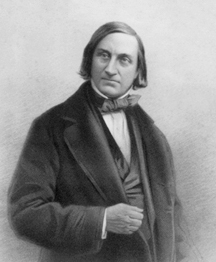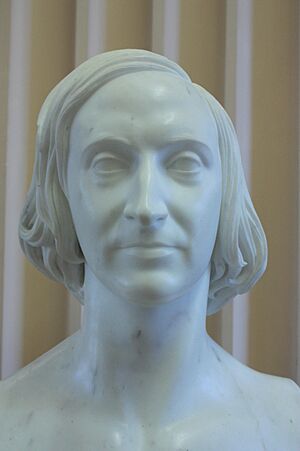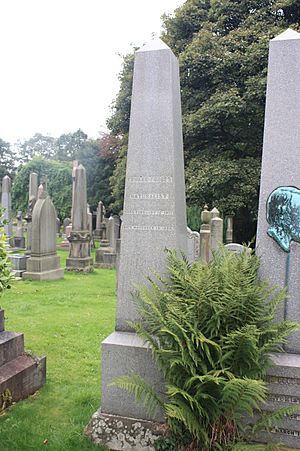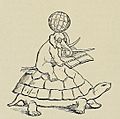Edward Forbes facts for kids
Quick facts for kids
Edward Forbes
|
|
|---|---|

Edward Forbes
|
|
| Born | 12 February 1815 |
| Died | 18 November 1854 (aged 39) Wardie, Edinburgh
|
| Nationality | Manx |
| Alma mater | University of Edinburgh |
| Known for | Azoic hypothesis |
| Scientific career | |
| Fields | Natural history |
| Institutions | Geological Society of London King's College London Geological Survey of Great Britain Royal School of Mines University of Edinburgh |
| Influences | Robert Jameson |
| Author abbrev. (botany) | E.Forbes |
Edward Forbes (born February 12, 1815 – died November 18, 1854) was a famous Manx naturalist. A naturalist is someone who studies nature, including plants, animals, and rocks.
Forbes came up with an important idea in 1846. He suggested that during the last ice age, plants and animals on mountains moved to lower areas. He also thought that some islands were once connected to the mainland. This helped explain why the same types of plants and animals are found in places that are now far apart. Even Charles Darwin, another famous naturalist, gave Forbes credit for this idea.
Forbes also had a theory called the "azoic hypothesis." He believed that no life could exist deep in the ocean, below a certain depth. However, scientists later proved this idea wrong.
Contents
Who Was Edward Forbes?
Early Life and Interests

Edward Forbes was born in Douglas on the Isle of Man. His father was a banker. From a young age, Edward loved collecting things from nature. He gathered insects, shells, minerals, fossils, and plants.
Edward was often sick when he was young, so he couldn't go to school between the ages of 5 and 11. In 1828, he started attending the Athole House Academy in Douglas.
Art and Education
In 1831, Forbes moved to London to study drawing. He wasn't accepted into the Royal Academy, but he kept practicing art on his own. Later in his life, he used his drawing skills to create funny pictures for his scientific books.
In 1832, Forbes began studying medicine at the University of Edinburgh. While there, he also studied natural history. He was very active in student groups and explored the natural world of the Isle of Man. His brother, David, also became a well-known mineralogist, someone who studies minerals.
Forbes's Travels and Discoveries
Exploring Nature Abroad
In 1833, Forbes traveled to Norway to study its plants. His findings were published in a science magazine. He also received money to study sea creatures in the Irish Sea by using a special tool called a dredge.
In 1835, he traveled through France, Switzerland, and Germany to learn about their natural history. In 1836, he decided to stop studying medicine. He moved to Paris to attend lectures on natural history, anatomy, geology, and mineralogy.
In 1837, Forbes went to Algiers in North Africa. He collected information for a paper about land and freshwater Mollusca (snails and slugs).
First Book and More Journeys
In 1838, Forbes published his first book, Malacologia Monensis. This book described all the mollusk species found on the Isle of Man. That same summer, he visited parts of Austria and Slovenia to collect plant samples.
Forbes's Scholarly Work
Studying Life in the Sea
In 1838, Forbes gave a presentation about how land snails were spread across Europe. He was then asked to study snails in the British Isles. In 1841, he published his book History of British star-fishes, which included many of his own drawings.
From 1841 to 1842, Forbes worked as a naturalist on a ship called HMS Beacon. He explored the plants, animals, and geology of the Mediterranean Sea.
In 1843, Forbes shared a report about the mollusks and Radiata (like starfish and jellyfish) in the Aegean Sea. He explained how the climate and the depth of the sea affected marine life. He divided the Aegean into eight different life zones. This is where he proposed his azoic hypothesis, saying that no life could exist below 300 fathoms (about 550 meters). This idea was later proven wrong by other scientists.
Forbes continued to publish important works on marine life. In 1848, he published a book about jellyfish called British Naked-eyed Medusae.
Working in London
In 1842, because he needed money, Forbes became the curator (manager) of the museum at the Geological Society of London. In 1843, he also became a professor of botany at King's College London.
In 1844, Forbes left his museum job to become a palaeontologist for the British Geological Survey. A palaeontologist studies fossils.
In 1848, Forbes married Emily Marianne Ashworth.
Botanical Studies and the Ice Age
In 1846, Forbes published an important essay. It was about how the plants and animals of the British Isles were connected to geological changes, especially during the ice age.
In his essay, Forbes divided the plants of Great Britain into five groups. He compared them to plants found in other parts of Europe. He believed that most British land animals and flowering plants moved to the area using land bridges that existed before, during, and after the ice age. While his specific theory was later updated, it was an important step in understanding how species spread.
In 1851, Forbes became a professor of natural history at the Royal School of Mines.
Mentoring Thomas Henry Huxley
Forbes was a very important mentor to a young biologist named Thomas Henry Huxley. Huxley later became a famous scientist who supported Darwin's ideas.
During Huxley's journey on the HMS Rattlesnake from 1846 to 1850, he sent news of his discoveries back to Forbes in the United Kingdom. Forbes then helped publish Huxley's findings. Forbes also helped Huxley get into the Royal Society (a very important scientific group) when Huxley was only 26 years old.
Forbes's Artistic Side
Edward Forbes was known for his scientific drawings. People said his drawings of animals, even invertebrates, often looked a bit like humans!
Final Years and Legacy

In 1853, Forbes became the president of the Geological Society of London. In 1854, he achieved a long-term goal: he was appointed professor of natural history at the University of Edinburgh. This was a very important position.
In the summer of 1854, Forbes gave lectures in Edinburgh. In September, he led the geology section at a meeting of the British Science Association.
Sadly, in November 1854, soon after the winter classes started at Edinburgh, Forbes became ill. He died on November 18, 1854, near Edinburgh. He was buried in the Dean Cemetery in Edinburgh.
In 1859, one of Forbes's former students, James Hector, named Mount Forbes in Banff National Park in Canada, in his honor.
Some of Forbes's works were published after he died, including On the Tertiary Fluviomarine Formation of the Isle of Wight (1856) and The Natural History of the European Seas (1859).
See also
 In Spanish: Edward Forbes para niños
In Spanish: Edward Forbes para niños
- European and American voyages of scientific exploration
Images for kids
-
Indian cosmogony and Fauna Sivalensis, cartoon by Forbes in the notebook of Hugh Falconer
-
Drawing by Forbes of geologist Gideon Mantell engaged in battle with flying dinosaurs on the English coastline, c. 1830s




